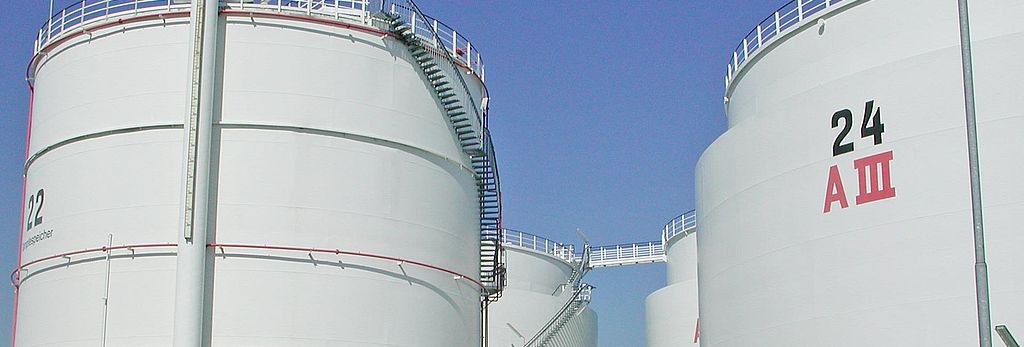
Middle distillates (gasoil)
What are middle distillates?
The term “middle distillates” is assigned to petroleum products obtained in the “middle” boiling range from about 180°C–360°C during the process of crude oil distillation. They are also called middle distillates because the products are removed at mid-height in the distillation tower during the multi-stage process of thermal separation.
In Germany, middle distillate is the technical term used for gasoil. Middle distillates, which are hence also known as gasoil, primarily include extra light heating oil (heating oil EL), and diesel fuel, as well as marine diesel oil (MDO) as an intermediate stage between middle distillates and heavy fuel oil, and jet fuel (also called Jet A-1 or kerosene).
A middle distillate is a clear, colorless to light yellow, flammable liquid. It has between ten and twenty carbon atoms, a density of not more than 0.860 kg/l at 15°C, and a flashpoint above 60°C.
How are middle distillates produced?
Middle distillates or gasoils are produced in a refinery by crude oil distillation, which means the crude oil is split into its component parts. After desalination, the crude oil, heated by tubular furnaces, flows into the distillation tower and is fractionated under atmospheric pressure. The tower consists of a certain number of levels, each at different temperatures (declining from bottom to top). At the lowest level, atmospheric residues accumulate. On the level above (in the middle boiling range) heavy middle distillate condenses, followed by light middle distillate, and then the more volatile fraction, naphtha. The gaseous components are collected at the top of the distillation tower. The middle distillates are drained from sidestreams in the distillation column. There are two primary fractions from which the sales products with defined properties are blended in post-distillation refining processes.
The gasoil cut is the starting material for the production of heating oil, diesel and jet fuel. Gasoil is often differentiated into two fractions (light gas oil, used mainly for jet fuel; and heavy gas oil, mainly for heating oil/diesel fuel). However, the transition between the different hydrocarbon groups is fluid. The boiling range of Jet A-1 kerosene is about 180-300°C and that of diesel fuel and extra light heating oil about 170-390°C.
Finished products are blends
Finished petroleum products are blends of various components that may have different compositions depending on the crude oil selected. Products that have not yet been specified for use as a heating oil (fuel to generate heat) or diesel (fuel to generate motion) are treated as middle distillates in statistics. To differentiate between extra light heating oil (HEL) and diesel fuel, whose properties are very similar, in Germany, the lower-taxed heating oil is colored using a red dye and Solvent Yellow 124 to prevent its use as a fuel to generate motion in vehicles, as that would be tax evasion and therefore punishable under law. Other countries have similar labeling practices, but often use other dyes.
Yield of middle distillates
Depending on the type of oil, the yield of middle distillates is between 25% and 40%. However, as demand for gasoil is higher, the residual fuels from crude oil distillation are split by catalytic or thermal cracking to increase the yield. In this way, 20% to 50% of the residual fuel can be converted to gasoil. Thus, the average yield of gasoils is about 40% of the volume of crude oil. The yield has been significantly increased through technical innovation in recent decades.
Middle distillates (gasoil) are traded, stored and distributed by the Mabanaft group, e.g. by Mabanaft Deutschland, Mabanaft Limited (UK), Mabanaft Energy Trading Inc. (USA), and Mabanaft Pte Ltd. (Singapore). The business unit Marketing including OIL! Tankstellen and the Petronord group also trades finished petroleum products. Oiltanking Deutschland offers storage solutions for fuels.
Mabanaft buiness unit Supply, Infrastructure & Trading
Mabanaft buiness unit Marketing
Fuels at Mabanaft Deutschland
Fuels at Mabanaft Limited, UK
Fuels at Petronord
Fuels at OIL! Tankstellen
Tank storage solutions of Oiltanking Deutschland
Status: December 2015
All information subject to change. Errors and omissions excepted.

